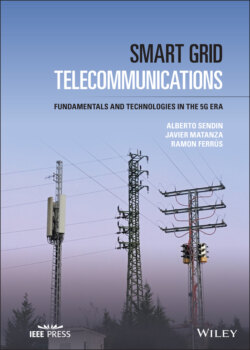Читать книгу Smart Grid Telecommunications - Ramon Ferrús - Страница 17
1.2.1.1 Frequency and Voltage
ОглавлениеThe frequency of the electricity signal in the different world regions is either 50 or 60 Hz. The waveform adopted by Europe, Asia, Africa, many countries in South America, Australia, and New Zealand for their electricity systems is 50 Hz. North America, some parts of northern South America, Japan, and Taiwan, opted for a frequency of 60 Hz [4, 5].
In contrast, the voltage levels that can be seen in the different parts of the grid span a much larger range of options. A widely accepted, though loosely precise, definition of the voltage levels is:
Low Voltage (LV), defined as “a set of voltage levels used for the distribution of electricity and whose upper limit is generally accepted to be 1000 V for alternating current” (IEV 601‐01‐26 [6]).
High Voltage (HV), defined as either “the set of voltage levels in excess of low voltage” or “the set of upper voltage levels used in power systems for bulk transmission of electricity” (IEV 601‐01‐27 [6]).
Medium Voltage (MV), defined as “any set of voltage levels lying between low and high voltage” (IEV 601‐01‐28 [6]).
The International Electrotechnical Commission (IEC) has standardized three‐phase AC rms voltage levels internationally in IEC 60038:2009 within the following ranges:
Having a highest voltage for equipment exceeding 245 kV: 362 or 420 kV; 420 or 550 kV; 800 kV; 1100 or 1200 kV highest voltages.
Having a nominal voltage above 35 kV and not exceeding 230 kV: 66 (alternatively, 69) kV; 110 (alternatively, 115) kV or 132 (alternatively, 138) kV; 220 (alternatively, 230) kV nominal voltages.
Having a nominal voltage above 1 kV and not exceeding 35 kV: 11 (alternatively, 10) kV; 22 (alternatively, 20) kV; 33 (alternatively, 30) kV or 35 kV nominal voltages (there is a separate set of values specific for North American practice).
Having a nominal voltage between 100 and 1000 V inclusive: 230/400 V is standard for three‐phase, four‐wire systems (50 or 60 Hz) and also 120/208 V for 60 Hz. For three‐wire systems, 230 V between phases is standard for 50 Hz and 240 V for 60 Hz. For single‐phase three‐wire systems at 60 Hz, 120/240 V is standard. Practically, LV consumers within most 50 Hz regions will eventually be delivered 230 Vac, and 110 Vac in 60 Hz regions.
Thus, it can be said that while LV is clearly below 1 kV, the boundary between HV and MV is commonly placed at 35 kV.
